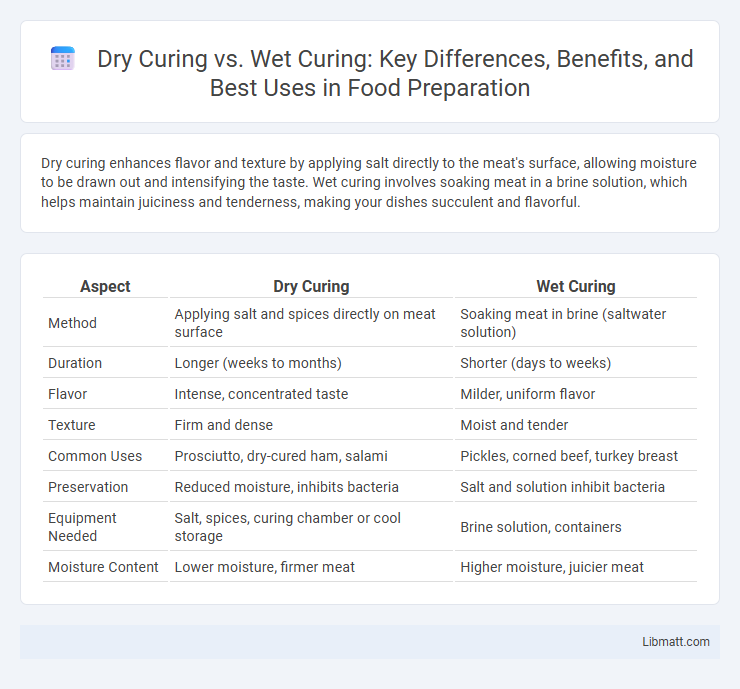Dry curing enhances flavor and texture by applying salt directly to the meat's surface, allowing moisture to be drawn out and intensifying the taste. Wet curing involves soaking meat in a brine solution, which helps maintain juiciness and tenderness, making your dishes succulent and flavorful.
Table of Comparison
| Aspect | Dry Curing | Wet Curing |
|---|---|---|
| Method | Applying salt and spices directly on meat surface | Soaking meat in brine (saltwater solution) |
| Duration | Longer (weeks to months) | Shorter (days to weeks) |
| Flavor | Intense, concentrated taste | Milder, uniform flavor |
| Texture | Firm and dense | Moist and tender |
| Common Uses | Prosciutto, dry-cured ham, salami | Pickles, corned beef, turkey breast |
| Preservation | Reduced moisture, inhibits bacteria | Salt and solution inhibit bacteria |
| Equipment Needed | Salt, spices, curing chamber or cool storage | Brine solution, containers |
| Moisture Content | Lower moisture, firmer meat | Higher moisture, juicier meat |
Understanding Dry Curing and Wet Curing Methods
Dry curing involves applying salt and seasonings directly to the surface of meat, drawing out moisture to preserve and enhance flavor through dehydration. Wet curing, or brining, soaks the meat in a saltwater solution, which helps maintain juiciness while infusing the meat with added flavors. Understanding these methods allows you to select the best technique for texture and taste preferences in your cured foods.
Key Differences Between Dry and Wet Curing
Dry curing involves rubbing salt and spices directly onto the meat's surface, drawing out moisture to create a concentrated flavor and firm texture, while wet curing submerges the meat in a brine solution, allowing for uniform salt penetration and enhanced juiciness. Dry curing results in a longer preservation process with a more intense taste, often used for products like prosciutto and dry-cured bacon, whereas wet curing is faster and ideal for items like ham and turkey. The choice between methods affects moisture content, flavor profile, texture, and curing time, making them suitable for different culinary applications and preferences.
The Science Behind Meat Preservation
Dry curing involves applying salt and sometimes sugar directly to meat, which draws out moisture through osmosis, inhibiting bacterial growth and enhancing flavor concentration. Wet curing, or brining, submerges meat in a saline solution, allowing salt to penetrate evenly while maintaining moisture content, resulting in a juicier texture. Both methods rely on controlling water activity and salt concentration to prevent spoilage by pathogenic bacteria, fundamentally preserving meat through dehydration and antimicrobial effects.
Benefits of Dry Curing
Dry curing enhances flavor concentration and preserves the natural texture of meats by allowing moisture to evaporate gradually. This method extends shelf life by creating a less hospitable environment for bacterial growth due to reduced water activity. Dry curing requires less equipment and chemicals compared to wet curing, making it a preferred choice for artisanal and traditional meat preservation.
Advantages of Wet Curing
Wet curing offers superior moisture retention, ensuring your meat remains tender and juicy throughout the process. This method allows for faster penetration of curing solutions, which enhances flavor consistency and reduces curing time compared to dry curing. Additionally, wet curing minimizes weight loss, resulting in a higher yield of quality product.
Flavor Profiles: Dry Cured vs Wet Cured
Dry curing enhances flavor profiles by intensifying the meat's natural taste through moisture loss and salt penetration, resulting in a robust, concentrated, and slightly firmer texture. Wet curing imparts a milder, more uniform flavor as the brine solution introduces additional spices and moisture, producing a juicier and more tender product. The choice between dry and wet curing ultimately influences the meat's aroma, saltiness, and overall depth of flavor.
Common Meats for Each Curing Technique
Dry curing is commonly applied to meats such as ham, bacon, and salami, where salt and seasoning are rubbed directly onto the surface to draw out moisture and intensify flavor. Wet curing, also known as brining, typically involves soaking or injecting meats like turkey, pork shoulder, and corned beef in a saltwater solution mixed with sugar and spices to enhance tenderness and juiciness. These curing methods are selected based on the desired texture and moisture content for specific meat cuts in charcuterie and preservation processes.
Equipment and Ingredients Needed
Dry curing requires coarse salt, sugar, and spices applied directly onto the meat's surface, along with airtight containers or curing chambers to control humidity and temperature. Wet curing involves submerging the meat in a brine solution made of water, salt, sugar, and sometimes curing agents like sodium nitrite, necessitating large, non-reactive vats or containers for the brine. Both methods benefit from refrigeration units to maintain consistent low temperatures, ensuring safe and effective preservation.
Safety Considerations in Curing Processes
Dry curing and wet curing each pose unique safety considerations critical to food preservation. Dry curing relies on controlled salt application, which reduces microbial growth by lowering moisture content, but improper salt levels or uneven application can increase spoilage risks. Wet curing, involving brine solutions, requires careful monitoring of salt concentration and temperature to prevent harmful bacterial growth, ensuring food safety through stringent hygiene and storage protocols.
Choosing the Right Curing Method for Your Needs
Dry curing enhances flavor concentration and texture by using salt and spices directly applied to meat, making it ideal for preserving small cuts or producing artisanal charcuterie. Wet curing, or brining, involves soaking meat in a saltwater solution, which ensures even moisture retention and is suited for larger cuts requiring uniform seasoning. Choose the curing method based on your desired taste intensity, meat type, and preparation time to achieve optimal results for your culinary needs.
Dry Curing vs Wet Curing Infographic

 libmatt.com
libmatt.com